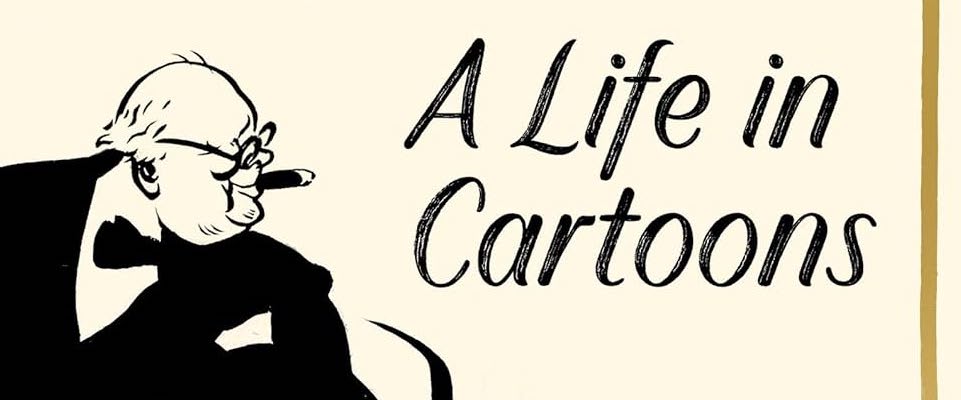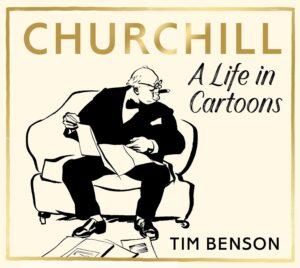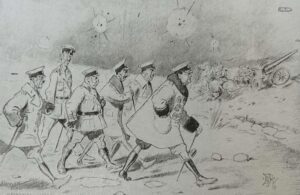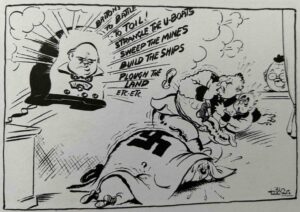
Tim Benson and the Cartoonists’ Churchill
Excerpted from “Tim Benson Presents Churchill, the Cartoonists’ Delight,” written for the Hillsdale College Churchill Project. For the original article, click here. To subscribe to free weekly articles from Hillsdale-Churchill, click here and scroll to bottom. Enter your email in the box “Stay in touch with us.” We never spam you and your identity remains a riddle wrapped in a mystery inside an enigma.
The perfect subject
Tim Benson, Churchill: A Life in Cartoons (London: Hutchinson Heinemann, 2024), 224 pages, Amazon $32.99, Kindle $14.99.
Tim Benson, of London’s Political Cartoon Gallery and Café, now turns his attention to a figure cartoonists loved to praise, ridicule and lampoon. Sometimes Churchill received all those treatments at once—notably by the great David Low. In 1954 Low penned a magnificent tribute showing the eighty-year-old Prime Minister being congratulated by all his previous incarnations. The caption was sincere: “To Winston, from his old friend and castigator, Low.”
Significantly, Churchill never resented the negative attention. His daughter Mary told Mr. Benson that in her youth she was “mystified” by what she deemed cruel and callous drawings of her father hanging around Chartwell. Indeed, he often bought and framed some.
 Praising Low in his essay “Cartoons and Cartoonists,” Churchill asserted that politicians feared neglect more than ridicule. They were “offended and downcast” when the cartoons stopped: “We are not mauled and maltreated as we used to be. The great days are ended.”
Praising Low in his essay “Cartoons and Cartoonists,” Churchill asserted that politicians feared neglect more than ridicule. They were “offended and downcast” when the cartoons stopped: “We are not mauled and maltreated as we used to be. The great days are ended.”
Churchill was irresistible to scribblers. His many characteristics and “props” were gifts to them: the stooped posture, tiny hats and balding locks of the young MP; the spotted bow tie, siren suit, cigar and V-sign of the seasoned statesman. All that, and his political prominence, made Churchill a central cartoon character for half a century.
A wartime chronicle
Given the vast Churchill cartoon universe, Tim Benson concentrated on greatest events. Thus the division into nine sections: “1914-20” covers the Great War and its aftermath; “1931-39” is entirely devoted to Appeasement and rearmament. The Second World War occupies six sections, 1940-45; and there is a brief postwar coda.
The book skips the young war correspondent and Conservative-turned-Liberal, who provided much grist for early cartoonists. Nor do we glimpse the Colonial Secretary and Chancellor of the Exchequer cartoonists lampooned in the 1920s. What we do get is a cartoon account of the years of Churchill’s greatest impact. Here Tim Benson is in his depth, providing many drawings few readers will have seen.
With the exception of the omitted periods, this is as comprehensive a reference as one could imagine. Early in the Great War, Churchill is pictured alongside an English bulldog. As First Lord of the Admiralty in Nelsonian garb, he hurls defiance at the Germans—who hurl it back. (Lüstige Blatter, the German humor magazine that mocked him in the Second World War, was already targeting him in the First.)
The Benson collection

The depth of this book can only be appreciated by owning a copy. Despite the cost (more on that later), no Churchillian should be without it. It is a kaleidoscope of WSC’s life and times.
For instance, I wrote of Churchill’s friend Hilaire Belloc, who toasted WSC’s departure from the government to fight in Flanders in 1915: “They drank Winston’s health and sang the French children’s song ‘Malbrouck s’en vat’en guerre’ (Marlborough goes off to war). They congratulated Churchill for “breaking loose from his official bondage to the gang of incapables….”
What fun to be reminded of Belloc’s tribute by the great cartoonist Edward Tennyson Reed, on page 18! Deftly, Benson accompanies the drawing with Churchill’s remarks after his first twelve days in the trenches: “I always get on with soldiers…. Do you know I am quite young again?”
Finest hours
A Life in Cartoons devotes itself mainly to the Second World War. The uplifting spirit of British cartoonists in the black days of 1940-41 is at once evident. A glow of resolve swept Britain; there were no carping media midgets such as we hear from today. That was a time, as Churchill put it, “when it was equally good to live or die.” Benson’s coverage invokes the spirit of thorse hard, glorious times.
Enemy cartoonists feature prominently. Early in 1940, the Daily Worker trumpets Churchill leading the poor little neutrals into war. Benson balances this with Leslie Illingworth’s drawing of a Nazi crocodile sprawled across Europe. Underneath it is Churchill’s quip: “Each [neutral] hopes that if he feeds the crocodile enough, the crocodile will eat him last.”
The pace picks up as Hitler invades Russia. Now German cartoonists wonder whether Stalin or Churchill will betray the other first. But the alliance holds. The Daily Sketch pictures Roosevelt leading a sailing race in a boat marked “Lend-Lease.” Melbourne’s Herald adds a dose of Aussie humor: Tojo being fed a cigar (lit end first), and wrestler Churchill putting a toe-hold on a screaming Mussolini.
Soon after Russia is invaded, the enemy-become-ally protests the lack of a “Second Front.” Pravda’s Boris Efimov regularly ridiculed Churchill’s “stalling,” Benson notes. As D-Day approaches, the Daily Sketch shows southern England bristling with tanks, guns, Americans, and a cigar-equipped figure saying: “First of all, gentlemen, welcome to our right little, tight little island.”
Depth and erudition

The array of rarely- or never-seen cartoons shows that this book could only be assembled by someone with a vast reach for material. For instance, Benson relies on the Fort Worth Star-Telegram (where else?) for Hal Coffman’s wry drawing of May 1940, when Churchill replaced Chamberlain. As Neville bails out of the government aircraft, Winston quips: “I always did wonder why you carried that umbrella.”
It is important also to note Benson’s narrative richness. He carefully explains the meaning of each cartoon, which today can be obscure. A typical example is “The Obstruction” by Jimmy Friell, in a 1944 edition of the Daily Worker: The Curzon Line being blocked by a soldier representing the exiled Warsaw government. Poland, Benson explains, objected to having its borders shifted. This high-quality research adds a vital dimension rarely found in art books.
An indispensable work
A small bone to pick has nothing to do with the author’s work. The cramped, horizontal, 8×7-inch format is disappointing in such a work. Yet the small pages contain a vast amount of white space that could have housed larger type and images. Many cartoons are too small to be fully appreciated without a magnifying glass.
Such a volume deserves a larger format and the option of a hardback, since it is not likely to gather dust. Readers will repeatedly pull it out for reference, and hardbacks hold up better.
The author’s erudition and vast resources deserved more from his publishers, who, though distinguished, do him a disservice. (I remember Heinemann, thirty years ago, refusing a minimal commitment to continue the companion volumes of the official biography. Martin Gilbert’s supporters went cap in hand to an old friend of Sir Winston for a donation that produced three more. Ultimately and thankfully, Hillsdale College took over and finished the job.)
Tim Benson (full disclosure) is an old friend who has aided this writer countless times over the years. Knowing in advance of his expertise, I expected the high quality of his work. Perusing the book is a never-ending revelation, and it quickly grows on you. A Life in Cartoons deserves a place in every serious Churchill library.
More on cartoons and cartoonists
“‘The Charlie Chaplin of Caricature’: Churchill on David Low,” 2020.
“Poy (Percy Fearon): The Classic Churchill Cartoonist,” 2022.
“Echoes and Memories: Foreword to Gary Stiles’s Churchill in Punch,” 2022.
“In Search of Winston Churchill’s First Political Cartoon,” 2021.
William John Shepherd, “Gary Stiles Offers a Brilliant Catalogue of Mr. Punch’s Churchill,” 2022.







One thought on “Tim Benson and the Cartoonists’ Churchill”
Just over a year ago, Stella and I spent several very pleasant days with you and Barbara. I was amazed by your library, and enjoyed a hour or so reading a book of cartoons, on WSC, of course. Such fun!
Comments are closed.